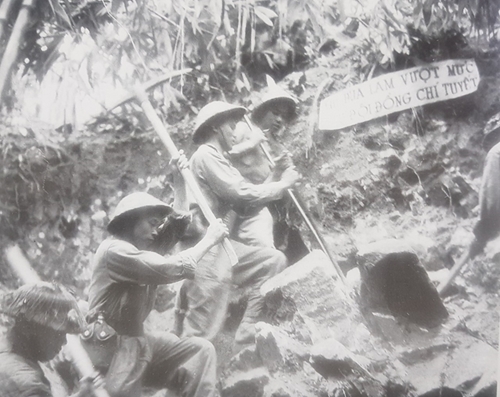Ensuring smooth transportation
Ensuring smooth transportation for weapons, equipment, and food was one of the hardest tasks during the Dien Bien Phu campaign. In October 1953, the Command of Dien Bien Phu Campaign assigned Engineering Regiment 151 to the Northwestern region to open roads. First, they were responsible for repairing roads for logistics trucks and artillery vehicles, then preventing mudslides and landslides caused by rain and floods; deactivating bombs and mines of the enemy.
    |
 |
|
Repairing a road in order to pull artillery to Dien Bien Phu battlefield. |
Notably, Engineering Regiment 151, together with youth volunteers and traffic workers, repaired and expanded roads with a total length of hundreds of kilometers, ensuring transportation for automobiles, bicycles and people carrying goods. In early 1954, the unit continued the task of widening rivers to transport goods smoother. The regiment established a team to use explosives to destroy 110 waterfalls and open waterway on the Nam Na River, contributing to transporting more than 2,000 tons of rice to former Lai Chau province (now Dien Bien and Lai Chau provinces) to supply for the campaign.
In late December 1953, the engineering force was tasked with ensuring smooth roads for moving wheeled artillery systems to Dien Bien Phu. As a result, the troops pulled 24 105mm artillery guns over a craggy mountainside into the battlefield in a secret and safe manner.
Building fortifications in the battlefield
Even though it was an offensive campaign, Viet Minh troops secretly built many fortifications near the enemy’s defense positions. These fortifications helped Viet Minh soldiers move safely and be able to attack the enemy for a long time, limiting casualties. The siege and encroaching warfare require the building of an offensive battlefield. After nearly a month, the engineering and artillery forces built 11 artillery fortifications, 21 anti-aircraft artillery fortifications as required, contributing to promoting the coordination between infantry and artillery forces. In mid-March 1954, the French colonists were extremely surprised as Vietnamese artillery attacked its bases in Him Lam, Doc Lap, and Ban Keo.
Troops’ movement network, including vertical and horizontal axes, together with a system of trenches in Dien Bien Phu battle field, paved the way to the victory.
Breaching enemy defensive line and digging tunnel
Due to the enemy’s defensive system around their bases with strong fire support, Viet Minh troops had to overcome these obstacles to advance deep into the enemy base. However, due to lack of specialized equipment, it was hard for Vietnamese soldiers to locate the right directions to start attacking the enemy and defending fortified fortifications. Meanwhile, seizing Hill A1 played a decisive factor during the campaign. Infantry Division 316 dug a tunnel, but because of technical downsides, the task was then assigned to Engineering Regiment 151.
On the night of April 20, 1954, our troops began digging a tunnel, though the enemy continuously threw grenades and opened fire.
After 15 days and nights, the engineering troops finished the 49-meter-long tunnel. On May 4, 1954, nearly 1,000kg of TNT were placed at the end of the tunnel. On May 6, 1954, the explosive block was detonated, destroying part of the tunnel and killing a number of enemies. On May 7, 1954, our troops captured Hill A1 and quickly crumbled the enemy’s Dien Bien Phu stronghold.
Translated by Minh Anh